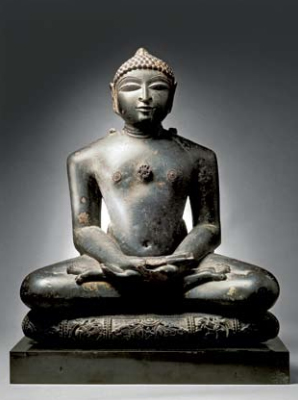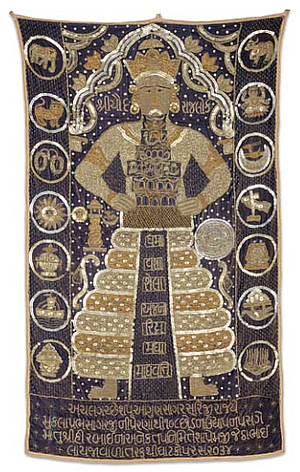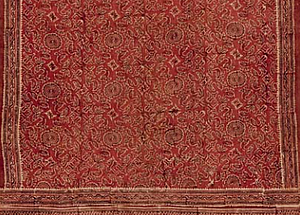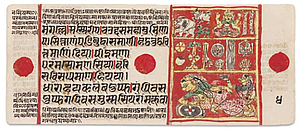
Centre of Jaina Studies Newsletter: SOAS - University of London
The exhibition Realms of Wonder: Jain, Hindu and Islamic Art of India, opening at the Art Gallery of South Australia in Adelaide on 4 October 2013 until 27 January 2014 is a milestone in the promotion of Jain art and studies in Australia. The exhibition features around fifty Jain works of art, including sculptures, paintings, manuscripts and textiles, and it is the first time that such an extensive display has ever been presented in Australia.[1]
The Art Gallery's decision to present Jain art, displayed in equal prominence with Hindu and Islamic art, seeks to nurture wider public appreciation of Jainism at a time when the religion is little known outside of academic circles and Australia's Indian community- there are Jain temples in several Australian capital cities. The collecting of Jain art by museums in Australia is very much in its infancy, although the achievement of major exhibitions in the northern hemisphere over the past decade is widely recognised.
The long delay in the promotion of Jain art in Australia reflects historical circumstances. In comparison to Great Britain, Europe and the United States, only in recent decades have art museums turned their attention to actively developing historical Indian collections. Institutions have subsequently focussed on acquiring key iconic pieces rather than assembling survey collections. Donors have typically preferred to support the purchase of stone sculptures as these can be permanently placed on view rather than more fragile works on paper or cloth which are often relegated to storerooms for conservation reasons.

Figure 1. Mallināth, the Nineteenth Tīrthaṅkara Gujarat or Rajasthan, 1182 Black stone, 64.0 cm (height) Gift of Michael Abbott through the Art Gallery of South Australia Foundation 2003 Art Gallery of South Australia (20033S4)

Figure 2. The World of Mortals, Manuṣya-loka Rajasthan, 18th century Ink and pigment on cotton, 84.0 x 72.0 cm The Michael Abbott Collection of Jaina Manuscripts (AO QC 2013)

Figure 3. The Universe in the Shape of a Human Gujarat, 1977 Velvet, silk, metallic thread, sequins, glass beads, couching and embroidery, 140.0 x 79.0 cm Promised Gift of Michael Abbott through the Art Gallery of South Australia Foundation 2013 (T12455)

Figure 4. Length of fabric, depicting woman with a parrot Gujarat, 14th-15th century Gujarat (Found in Indonesia) Cotton, block-printed, batik and mordant dye, 521.0 cm x 100.5 cm Gift of Michael Abbott through the Art Gallery of South Australia Foundation 2008 Art Gallery of South Australia (20083A28)

Figure 5. Length of fabric, depicting haṃsa geese Gujarat, 15th-16th Century (Found in Indonesia) Cotton, block-printed and mordant dye, 521.0 x 98.0 cm Gift of Michael Abbott through the Art Gallery of South Australia Foundation 2008 Art Gallery of South Australia (20083A30)

Figure 6. Devānandā's Fourteen Lucky Dreams Folio 4v from a Kalpasūtra manuscript Gujarat or Rajasthan, ca. 1575 Pigments and gold on paper, 11.0 x 25.5 cm The Michael Abbott Collection of Jaina Manuscripts (Vol. 2 T12464 Kalpa S_8873)
Despite the emphasis on acquiring individual iconic pieces, Indian art exhibitions in Australia until now have invariably presented Jain art subsumed within broader thematic concepts. The Art Gallery of New South Wales' exhibition Dancing to the Flute: Music and Dance in Indian Art (1997) included several exquisite Jain manuscript folios depicting entertainments and a Jain bronze throne-back decorated with celestial musicians. Goddess: Divine Energy (2006) displayed the Gallery's tenth-century stone stele of a yakṣa-yakṣī couple, together with Jina, alongside Hindu and Buddhist divine couples. In a radical departure from these previous exhibitions, Realms of Wonder seeks to present Jain art as a living expression of very distinct spiritual beliefs and practices. This approach offers the curator the exciting opportunity to explore the defining elements of the Jain aesthetic in a scholarly manner while creating an exhibition whose narrative is inspiring and meaningful for the general audience.
Realms of Wonder presents Jainism through a selection of diverse media. The focus of the display space is a seated Sri Mallinatha from the Gallery's permanent collection. (Figure 1) The statue is dated by the donors' dedication, appearing on the base, to 1182 CE and the inscription is a reminder of the importance of text as a key element in the religion's art. The stone images in the exhibition are accompanied by a rich selection of manuscript works and paintings, extending over a time-frame of five hundred years, including Kalpasūtra folios (Figure 6), maps of Manuṣya-loka (Figure 2), and other texts such as the Saṃgrahaṇī-sūtras that all reveal the great heritage of Jain graphic arts.
Jain textiles feature among the highlights in Realms of Wonder with four hangings including The Universe in the Shape of a Human (Figure 3), as well as depictions of Tirthaṅkaras and Digambara monks. The velvet cloths are lavishly embroidered in couched gold and silver metallic thread, with additional stitched sequins and glass beads.
The Universe in the Shape of a Human, with a border of auspicious symbols and dated by inscription to VS 2034/1977, testifies to the continuity of this unique form of Jain art into recent times.
The historical significance of textiles in Jain culture is perhaps best documented in early Indian trade cloths that have been preserved as heirlooms in Indonesia. The presence of Gujarati Jains, working alongside Hindu and Muslim cloth merchants in maritime commerce, is well documented in period sources. It is uncertain what role Jains had in the actual production of trade textiles but several surviving examples suggest the influence of Jain taste in the choice of styles and subject matter. A fourteenth-fifteenth century trade textile, featuring elegantly apparelled women (Figure 4), has a remarkably close resemblance to contemporary western Indian figurative painting documented in surviving Jain manuscripts. A fifteenth to sixteenth-century cloth with a haṃsa geese motif (Figure 5) appears to be the same pattern seen worn on figures in Jain manuscripts. An example of one such Kalpasūtra illustration is displayed in Realms of Wonder alongside a fifteenth to sixteenthcentury haṃsa textile, bearing a Surat dyer's and merchant's stamps, from the Art Gallery's collection.
James Bennett is the Curator of Asian Art at the Art Gallery of South Australia.
 James Bennett
James Bennett